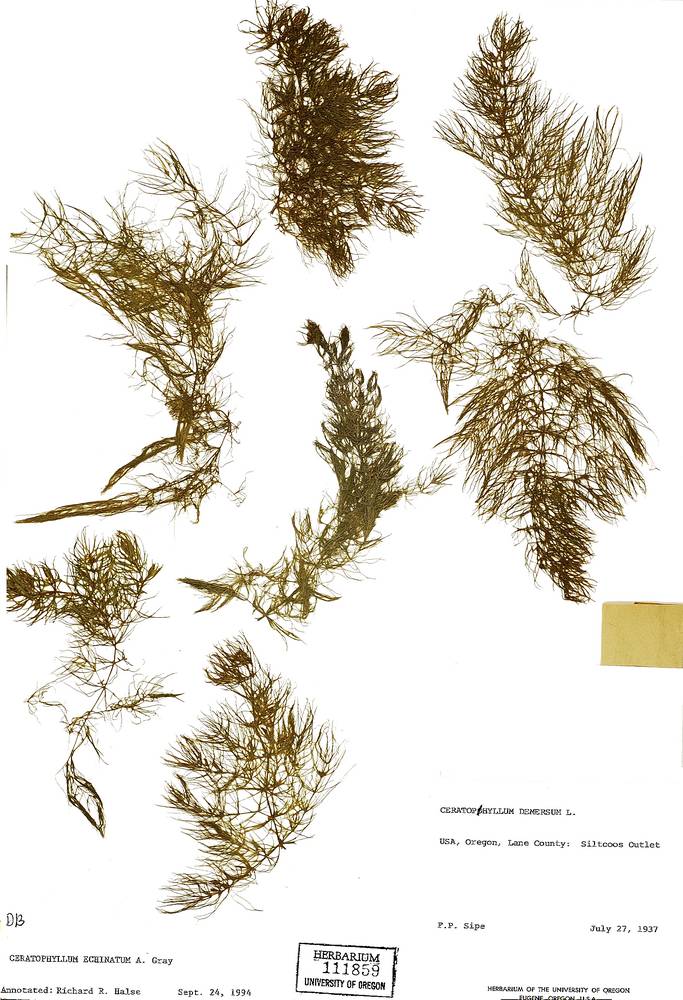
Plants submerged or floating.
Stems 1–10 dm, flaccid.
Leaves 5–12 per whorl, forked 3–4 times, 5–15 mm.
Flowers subtending bracts 1–2 mm.
Fruits flattened, ellipsoid, 4–6 mm, dark green to brown; persistent styles ~1–8 mm.
2n=24.
Fresh water ponds, lakes, marshes. Flowering Jun–Aug. 0–50 m. Est. WA; north to British Columbia; eastern North America. Native.
Herbarium records indicate a population of C. echinatum was present in Siltcoos Lake (Lane County) from 1937 until at least 1951. It has not been reported in Oregon since. Unlike C. demersum, this species is not tolerant of brackish waters and prefers cooler, clearer, and more acidic waters.
as described under Ceratophyllum echinatum
Stems to 1 m; apical leaf whorls not densely crowded. Leaves dark green or olive-green, fine-textured. Leaf blade simple or forked into 2-10 ultimate segments (forking of largest leaves 3d or 4th order), proximal segments often conspicuously inflated, mature leaf whorls 25-55 mm diam., marginal denticles weak and inconspicuous, weakly exserted, not raised on broad base of green tissue; 1st leaves of plumule forked. Achene dark green or brown, body (excluding spines) 4.5-6 × 2.5-4.5 × 1.5-3 mm, basal spines 2 (rarely absent), straight or curved, 1-5 mm, marginal spines 2-13, 0.5-6.5 mm, terminal spine straight, 1.5-7.5 mm, margins winged. 2 n = 24.Flowering spring-summer. Fresh water of lakes, ponds, marshes, swamps; 0-500 m; B.C., Man., N.B., N.S., Ont., Que.; Ala., Ark., Conn., Del., D.C., Fla., Ga., Ill., Ind., Iowa, Kans., Ky., La., Maine, Md., Mass, Mich., Minn., Miss., Mo., N.H., N.J., N.Y., N.C., Ohio, Okla., Oreg., Pa., R.I., S.C., Tenn., Tex., Vt., Va., Wash., W.Va., Wis.Principally an eastern North American species--and the only species of its genus endemic to North America-- Ceratophyllum echinatum is disjunct in the Pacific Northwest as a result of repeated Pleistocene glaciation. The habitats of C . echinatum are typically more acidic (avg. pH 6.6) than those of C . demersum (avg. pH 7.4). The two species only rarely coexist. Ceratophyllum echinatum also thrives in cooler, clearer, and more oligotrophic water than C . demersum and often is found in more ephemeral sites, such as shrub swamps (e.g., with Cephalanthus occidentalis ) and beaver ponds.This species, relatively uncommon, is fast disappearing from much of its range because of habitat alteration or destruction and the introduction of nonindigenous species; steps should be taken to secure its conservation. Unlike Ceratophyllum demersum , C . echinatum does not attain status as a serious weed.